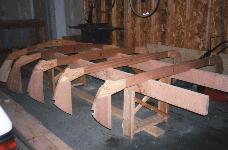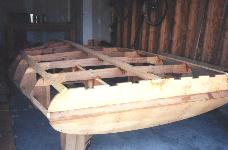Building the Thunderbolt
by Mark Dietel
Page 2
Started out by purchasing a frame kit from
Glen-L. I did not have any luck finding a marine lumber supplier locally
so I had a load of Sitka spruce and okoume plywood shipped in from a
nationally advertised supplier (probably not the cheapest way to get
lumber). The
Sitka spruce was used for stringers and longitudinals. This lumber is
light, strong and proved easy to work and glue; however, I would probably
choose mahogany if I had to do it again. Sitka spruce is very expensive
and, if not for the lack of knots, looks like ordinary lumberyard pine.
When the wood arrived, felt like I paid big bucks for a load of scrap
lumber. I bought both BS1088 and the lessor BS5066 grade okoume plywood
for planking. If not for the stamp, it would be impossible to tell the
difference. My supplier said both grades have solid cores and are glued
with the same waterproof glue, but BS1088 must undergo more stringent
testing. BS1088 okoume ply is nearly twice the price -- a lot to pay for
the stamp! The BS5066 okoume I purchased is excellent and cost just
slightly more than marine fir (from my mail order supplier).
The
Sitka spruce was used for stringers and longitudinals. This lumber is
light, strong and proved easy to work and glue; however, I would probably
choose mahogany if I had to do it again. Sitka spruce is very expensive
and, if not for the lack of knots, looks like ordinary lumberyard pine.
When the wood arrived, felt like I paid big bucks for a load of scrap
lumber. I bought both BS1088 and the lessor BS5066 grade okoume plywood
for planking. If not for the stamp, it would be impossible to tell the
difference. My supplier said both grades have solid cores and are glued
with the same waterproof glue, but BS1088 must undergo more stringent
testing. BS1088 okoume ply is nearly twice the price -- a lot to pay for
the stamp! The BS5066 okoume I purchased is excellent and cost just
slightly more than marine fir (from my mail order supplier).
The Glen-L frame kit turned out to be an
excellent decision. It cost me no more than having raw lumber shipped in,
and the quality of the lumber and  workmanship are top notch. The frame kit also
enabled the hull form to take shape quickly during the early stages of
construction -- this is a great confidence builder! Before starting
construction, I purchased a table saw, thickness planer and a hand-held
power planer. These are quite inexpensive at discount home stores and
proved satisfactory. The only other tools required are the usual hand and
power tools that any do-it-yourselfer would have in his toolbox. My
lumber was shipped rough, otherwise the thickness planer would not be
necessary.
workmanship are top notch. The frame kit also
enabled the hull form to take shape quickly during the early stages of
construction -- this is a great confidence builder! Before starting
construction, I purchased a table saw, thickness planer and a hand-held
power planer. These are quite inexpensive at discount home stores and
proved satisfactory. The only other tools required are the usual hand and
power tools that any do-it-yourselfer would have in his toolbox. My
lumber was shipped rough, otherwise the thickness planer would not be
necessary.